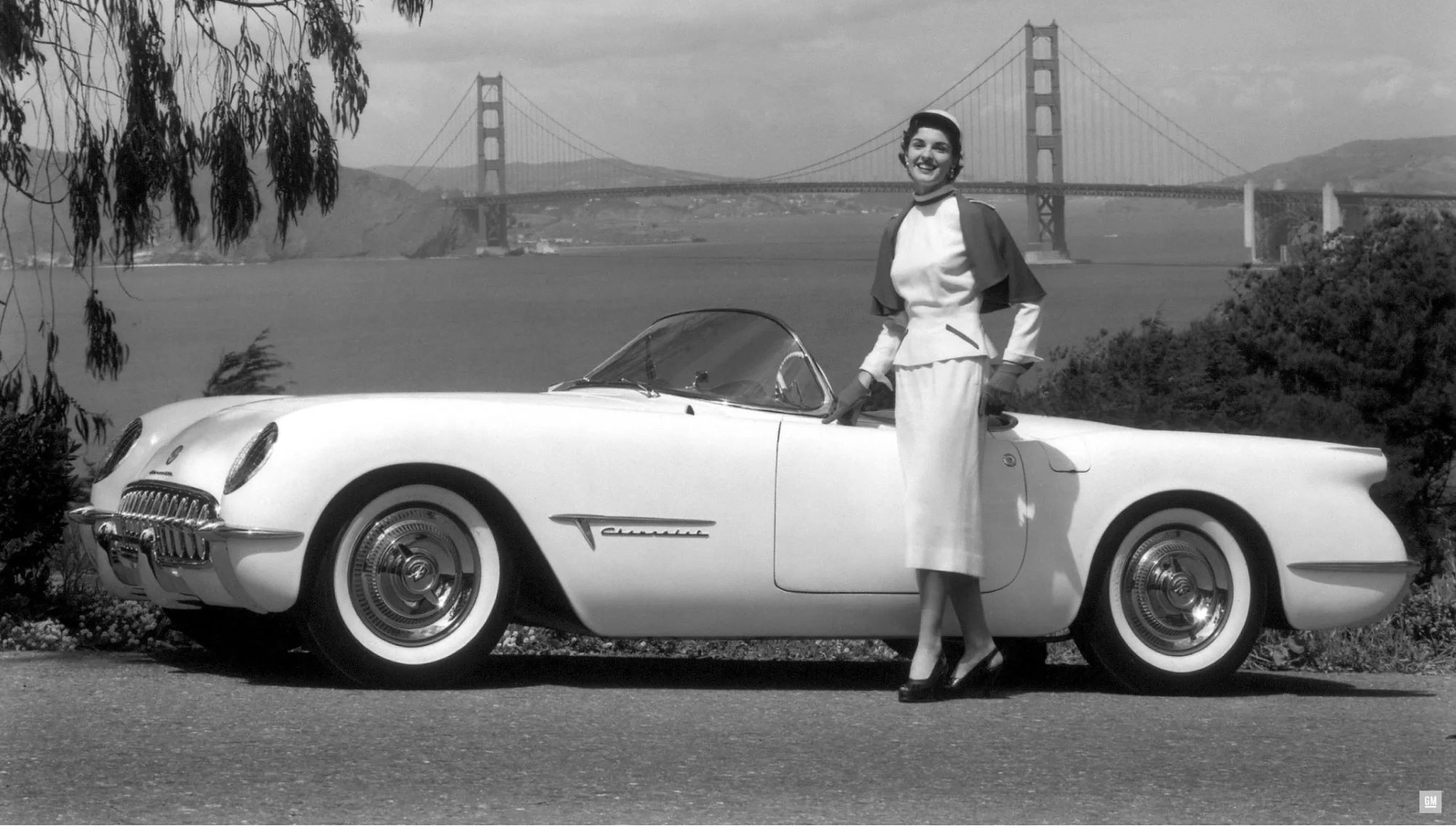
First generation Corvette, 1953 through 1962
1953
-

Original Chevrolet Corvette logo, 1953. The first full-scale Corvette concept was displayed as a “dream car” at GM’s Motorama in New York’s Waldorf Astoria Hotel in January 1953
- Six months after the GM Motorama debut, the first production Corvette rolled off the assembly line in Flint, Michigan, on June 30.
- Fiberglass was chosen over steel for the Corvette’s body material for two reasons:
- tooling was easier to create and it allowed designers more freedom to create rounded shapes.
- All 300 Corvettes produced for were created equal: Polo White with red interior.
- Only two options were available on the Corvette: a heater and an AM radio (with the antenna sandwiched into the fiberglass trunk lid).
- Corvette production moved from Flint, Michigan, to St. Louis, Missouri, in December, 1953.
The first production Corvette is assembled in Flint, Mich., on June 30. In all, 300 of the fiberglass-bodied roadsters are built, all of them in Polo White with a Sportsman Red vinyl interior. All are powered by the “Blue Flame Six,” a 6-cylinder in-line engine rated at 150 horsepower with three side-draft carburetors. Each car has a Powerglide automatic transmission and six-volt electrical system. Only two options are offered – a heater and an AM radio with the antenna sandwiched into the fiberglass trunk lid. In December, production of the Corvette moves to St. Louis, Mo.
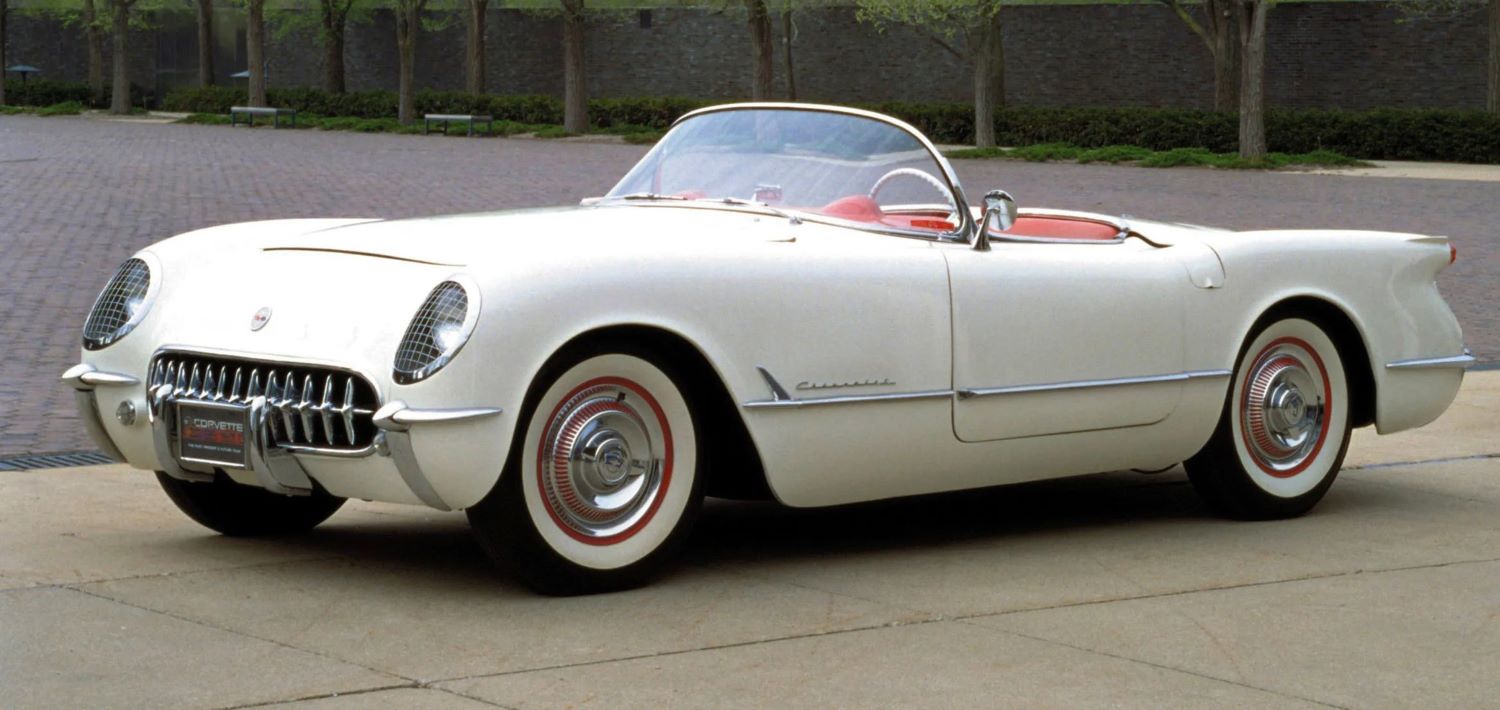
The Little White Corvette ~ June 30 1953
The first Chevrolet Corvette, a white convertible roadster with a red interior, was produced in temporary facilities in Flint, Michigan. The Corvette was born as a dream car for the 1953 Motorama. The first all-fiberglass-bodied American sports car, the Vette turned heads with its release.
The sleek lines of the 1953 edition are among the best produced by American car design. But underneath its exterior, the first Corvette’s inner workings were less than impressive. They were comprised mostly of existing General Motors’ (GM) parts, including a “Blue Flame” inline six-cylinder engine, a two-speed automatic transmission and the drum brakes from Chevrolet’s regular car line.
The Corvette was at best a half-hearted attempt at a sports car. Events, however, combined to keep the Chevrolet Corvette in production in spite of its dismal sales record early on. Ford’s release of the T-Bird in 1954 necessitated the existence of the Corvette as GM’s answer in the small, sporty market. GM gradually improved the vehicle’s design until, by 1961, it was undoubtedly America’s favorite sports car. Unique in American history in its longevity as a model, the Corvette has remained an impressive machine throughout its lifetime. In recent years, GM has been able to rank the Corvette among the world’s elite sports cars in 0 to 60 times, top speed, and overall muscle. The Corvette’s list price modestly remains half of its European competitors.
1953 Corvette Production Fun Facts:
- 1953 Corvette Production: 300 built
- 1953 Corvette MSRP: $3,498.00 (including shipping)
- Six months after the GM Motorama debut, the first production Corvette rolled off the assembly line in Flint, Michigan, on June 30.
- Fiberglass was chosen over steel for the Corvette’s body material for two reasons: tooling was easier to create and it allowed designers more freedom to create rounded shapes.
- All 300 Corvettes produced for were created equal: Polo White with red interior.
- Only two options were available on the Corvette: a heater and an AM radio (with the antenna sandwiched into the fiberglass trunk lid).
- Corvette production moved from Flint, Michigan, to St. Louis, Missouri, in December, 1953.
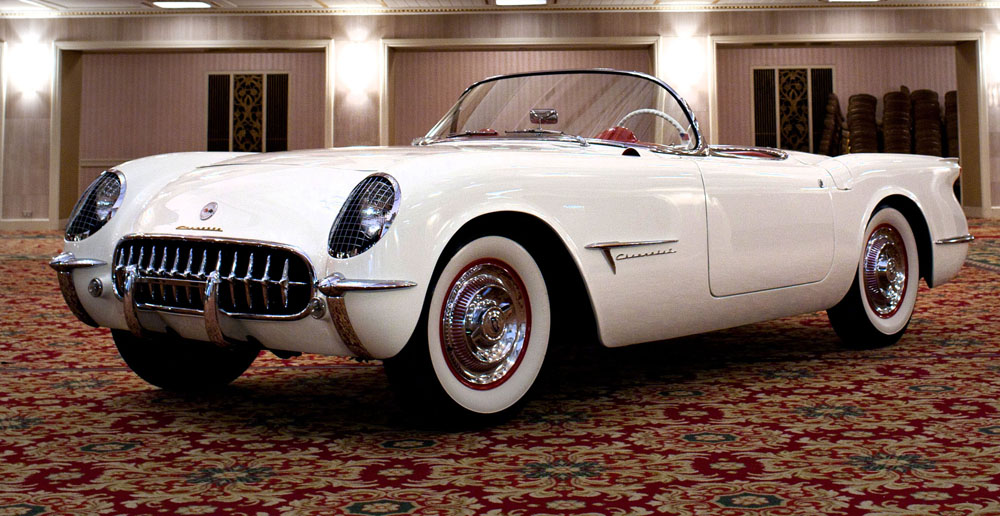
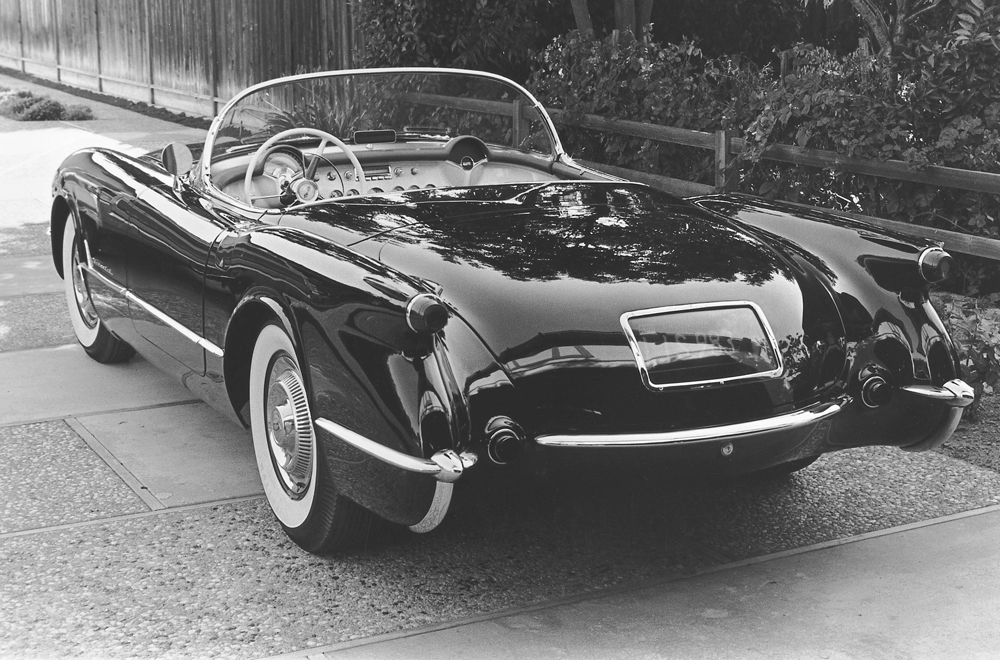
1954
Three new exterior colors (Blue, Red and Black) and a new interior color (Beige) are offered. Corvette production begins its first full model year in St. Louis. During the year, engine horsepower increases to 155. Nine options are now available; a beige interior is added plus three new exterior colors – blue, red and black.
In 1954 the Corvette production moved from Flint, Michigan to St, Louis, Missouri. It was here that mass production of the Corvette would begin. With the introduction of Chevrolet’s first V-8 engine in 1955, through the influence of GM engineer Zora Duntov, the car’s performance greatly improved. The increase in performance helped bridge the gap from cruiser into the high performance sports car that the Corvette is known to be today. So important were Duntov’s contributions during the beginning of the Corvette’s history that he is often credited with the nickname “Father of the Corvette.” By the mid-1960s, the Corvette had secured its reputation as America’s favorite sports car.
Specifications
- Engine – “Blue Flame 150,” 150-horsepower, high-compression, 6-cylinder valve-in-head engine; three side-draft carburetors, shielded ignition, dual exhaust system, reserve water tank.
- Transmission – Powerglide; with floor-mounted selector lever.
- Drive Line – Hotchkiss drive; 3.55 to 1 ratio, hypoid axle.
- Wheels – Five wheels; full-size chrome disks with simulated hubs. Five 6.70-15 white sidewall tires.
- Steering – 16 to 1 ratio, anti-friction gear; Center-Point linkage. Nearly vertical, 17-1/4″, two-spoke steering wheel.
- Brakes – Hydraulic, 11″, self-energizing brakes; bonded linings. Mechanical parking brakes; pull-handle and alarm light.
- Suspension – Knee Action with ride stabilizer; out-rigger type, 51″, 4-leaf rear springs. Direct double-acting shock absorbers.
- Frame – Extra-rigid, X-member-braced Box Girder frame.
- Gas Tank – 17 gallons; behind seats. Concealed filler at side.
- Body – 2 passenger, open-cockpit body of glass-fiber reinforced plastic; light, strong, durable, rust-proof, quiet and easy to repair. Wide doors with inside release lever.
- Compartments – Front-hinged hood with automatically latching support. Large luggage locker with spare wheel well under floor, and lockable, counter-balanced lid. Concealed well for top in rear deck behind seats. Saddle-covered door pockets.
- Windows and Top – Chrome-bound, one-piece, curved safety plate glass windshield; 53-degree slant. Removable, chrome-bound, plastic side windows with ventipanes. Manually adjusted fabric top with plastic rear window.
- Colors – Polo White, Pennant Blue, Sportsman Red, Black
- Car Dimensions – Wheelbase, 102″. Length, 167″. Height, 33″ at door top. Road Clearance, 6″. Width, 72.2″. Tread, 57″ front, 59″ rear. Body Weight, 410 lb.

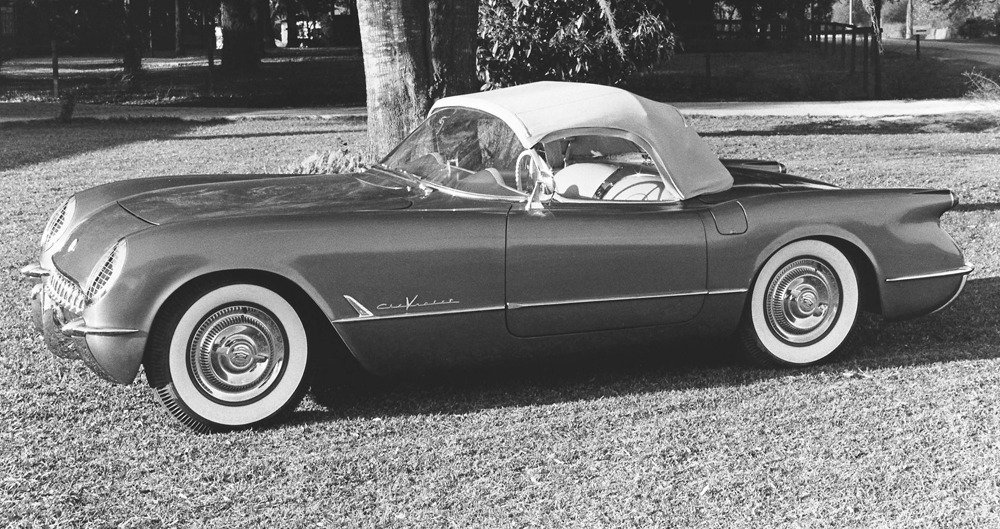
1955
The small-block V8 displacing 265 cubic inches is introduced, and a three-speed manual transmission becomes available. A new engine, the 195 HP, 265 cubic-inch V8 with a single four-barrel carburetor, gives a glimpse of performance to come. This is the first year Corvette offers a V8 engine, and the last year for a six-cylinder. Customers ordering V8 equipped Corvettes get the added bonus of a 12-volt electrical system. A three-speed manual transmission is also available.
Specifications
- Engines – Choice of 195-hp “Turbo-Fire V8” with 4-barrel carburetor; or 155-hp “Blue Flame” Six with 3 side-draft carburetors. Valve-in-head design, 8:1 compression ratio, high-lift camshaft, dual exhaust system, shielded ignition.
- Transmission – Powerglide or Synchro-Mesh 3-speed. Floor-mounted selector lever.
- Drive Line – Hotchkiss drive. Hypoid axle: 3.55:1 with Powerglide; 3.70:1 with Synchro-Mesh.
- Tires – Five 6.70-15 tubeless tires.
- Steering – Anti-friction gear, 16 to 1 ratio; balanced linkage. Nearly vertical, 17-1/4″ two-spoke steering wheel.
- Brakes – Hydraulic, 11″ self-energizing brakes; bonded linings. Pull-handle parking brake.
- Suspension – Independent front suspension, ride stabilizer. Four-leaf rear springs, outrigger mounted. Direct double-acting shock absorbers.
- Frame – Extra-rigid X-member-braced box girder frame.
- Fuel Tank – Capacity: 17 gal. Concealed side filler.
- Body – 2-passenger, open-cockpit body of glass-fiber-reinforced plastic; light, strong, durable, quiet, rustproof, and easy to repair. Wide doors with inside release.
- Compartments – Front-hinged hood with automatically latching support. Large luggage locker with spare-wheel well under floor, and lockable counterbalanced lid. Concealed well for top in rear deck behind seats. Saddle-covered door pockets.
- Windows and Top – Chrome-bound, one-piece, curved safety plate glass windshield; 53-degree slant. Removable chrome-bound plastic side windows with ventipanes. Manually adjusted fabric top with plastic rear window.
- Colors – Exterior: Polo White, Pennant Blue, Corvette Copper, Gypsy Red, Harvest Gold. Interior: Red, Light Beige, Dark Beige, Yellow
- Car Dimensions – Wheelbase, 102″. Length, 167″. Height, 33″ at door top. Road Clearance, 6″. Width, 70″
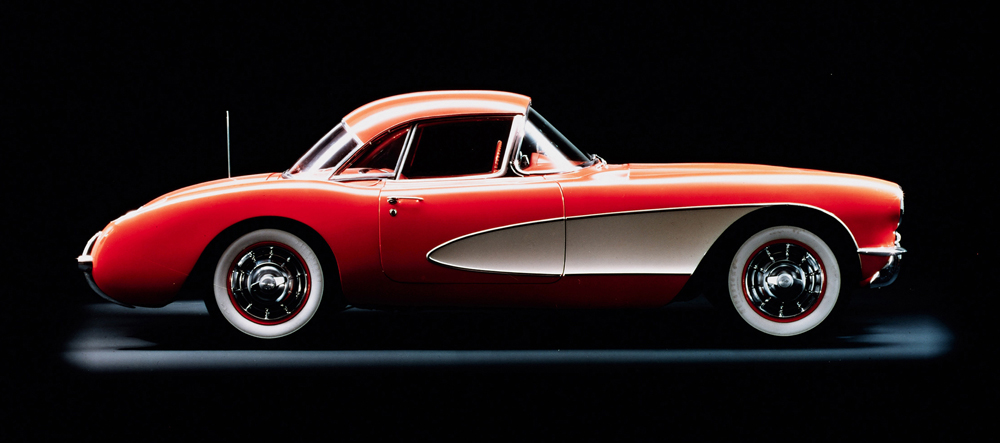
1956
Roll-up windows are introduced when Corvette’s styling was revised. Corvette’s styling is modified, and the new body features exposed headlamps, sculptured side coves and roll-up windows in place of the original car’s side curtains. Factory-installed removable hardtops are offered for the first time, and a transistorized radio marks the advent of solid-state electronics on the Corvette. With the four-barrel carburetor, the 265 cubic-inch V8 has stock power of 210 hp, but an engine as powerful as 240 hp is available.
- Engine: “Turbo-Fire Special V8,” Super-efficient valve-in-head design, 265-cubic inch displacement, 3.75″ bore x 3.0″ stroke, 9.25 to 1 compression ratio. 225 horsepower at 5200 rpm. Torque 270 foot pounds at 3600 rpm. Special high-lift camshaft, high-speed valve mechanism. Polished aluminum rocker covers. Dual four-barrel carburetion, buff aluminum racing-type air cleaners, special intake manifold. Full pressure lubrication system with full-flow oil filter. High power exhaust headers and full dual exhaust system. Shielded ignition, 12-volt electrical system. Engine precision balanced after assembly.
- Transmission: Choice of special high-performance 3-speed close-ratio Synchro Mesh (2.2:1 low and reverse, 1.31:1 second, 1.1 high) with high-capacity 10-inch coil-spring clutch, or optional Powerglide special automatic transmission. Floor mounted gear or range selector.
- Rear Axle: High torque capacity axle; 3.55:1 ratio standard, 3.27:1 ratio optional with either Synchro-Mesh or Powerglide.
- Chassis: Extra-rigid X-member-braced box girder frame. Independent coil front suspension with ride stabilizer. Self-lubricating four-leaf rear springs, out-rigger mounted. Direct double-acting shock absorbers. Full anti-friction 16:1 ratio steering gear, balanced linkage. Competition-type steering wheel with three shock absorbing spring-steel spokes. Hydraulic 11-inch self-energizing brakes with new bonded linings, pull-handle parking brake. Suspended brake pedal. Choice of black or white sidewall standard 6.70-15-4 ply high-speed nylon racing type tires. Decorative wheel covers with simulated knock-off knobs. 16.4 gallon fuel tank with concealed side filler.
- Body Features: Glass-fiber reinforced plastic with sculpted side panels; light, strong, durable, quiet, rustproof, easy to repair. Distinctive embossed hood, front hinged, with automatic support, inside release. Simulated twin fender air scoops. Two-passenger compartment, large luggage locker with spare-wheel well under floor, concealed top well behind seats. Unique Corvette crossed-flag emblems on hood and trunk lid. Twin exhaust ports integral with rear bumpers. Chrome-bound, one-piece, curved safety plate glass windshield. Power-operated fabric top with wide plastic rear window. Richly trimmed quick-change hardtop with rear quarter windows and full-vision rear window.
- Dimensions: Wheelbase, 102″. Length, 168.01″. Overall height: top down 49.20″; Convertible top, 51.09″; hardtop, 50.98″. Height at door 32.55″. Road clearance 6″. Width, 70.46″. Tread, 57″ front, 59″ rear.
Interior Features: Form-fitting vinyl-covered seats, individually adjustable, with safety belt. Wide doors with built-in arm rest, push-button door handle, key lock, inside door release, swing-out door hinges. Choices of crank-operated or power window lifts. Ash tray and glove compartment between seats; padded instrument panel and doors, rubber-backed carpeting, metal door kick panels, sills, and step plates. Signal-seeking radio, heater, directional signals, electric clock, cigarette lighter, tachometer, outside and inside rear-view mirror, windshield washer.
Color Options: Onyx Black, Aztec Copper, Cascade Green, Arctic Blue, Venetian Red and Polo White
Total production: 3,467 Corvettes built, all convertibles.

1957
Corvettes equipped with fuel injection were available with an optional steering column-mounted tachometer. Factory-installed fuel injection and an optional 4-speed manual transmission are offered. Corvettes equipped with fuel injection offer an optional tachometer mounted on top of the steering column. Thanks to fuel injection, the 283 cubic-inch V8 achieves 283 hp – the first engine in an American production car to offer one horsepower for every cubic inch of displacement.
Standard equipment with the 1957 Corvette was a special 3-speed close ratio transmission. Also, in tailoring the Corvette to individual taste, a special version of the smooth Powerglide transmission was available as an extra-cost option with certain engines. In any combinations, the Corvette driver commands the most remarkable road car in America- and a show stopper for looks, luxury, and comfort.
- Engine: Valve-in-head V8, 283-cubic-inch displacement, 3.88″ bore x 3.0″ stroke, 9.5 to 1 compression ratio. 220 h.p. at 4600 r.p.m. with 4-barrel carburetor. 245 h.p. at 5000 r.p.m with Ramjet Fuel Injection system. High-lift camshaft, hydraulic valve lifters. Independent operating mechanism for each valve. Cast aluminum rocker covers on optional engines. Buffed aluminum racing-type oil-wetted air cleaners, chrome plated single air cleaner with fuel injection. Five-bearing forged steel crank-shaft. Special replaceable-insert main and connecting rod bearings. Full-pressure lubrication system with full-flow oil filter. Full dual exhaust system. Shielded ignition, 12-volt electrical system. Engine precision balanced after assembly.
- Maximum performance 283 h.p. at 6200 r.p.m. engine available only with close-ratio Synchro-Mesh features Ramjet Fuel Injection system, 10.5 to 1 compression ratio, competition-type camshaft, and high-speed valve system with special valve springs, spring dampers, and mechanical valve lifters.
- Transmission: Choice of special 3-speed close-ratio Synchro-Mesh (2.2:1 low and reverse, 1.31:1 second, 1:1 high) with high-capacity 10-inch semi-centrifugal coil spring clutch, or optional Powerglide special automatic transmission. Floor mounted gear or range selector.
- Drive System: Hotchkiss drive, with unit-balanced tubular propeller shaft and universal joints.
- Rear Axle: Semi-floating hypoid with single unit banjo housing. Axle ratios: with Powerglide, 3.55:1; with close-ratio Synchro-Mesh 3.70:1. Positraction axle with 3.70:1, 4.11:1, or 4.56:1 ratio optional with close-ratio Synchro-Mesh only.
- Frame: Extra-rigid box girder frame reinforced with “X” member.
- Suspension: Independent coil spring front suspension with ride stabilizer. Outrigger mounted semi-elliptic rear springs. Direct double-acting shock absorbers.
- Steering: Full anti-friction steering gear with balanced steering linkage, 16:1 overall ratio. Turning diameter (curb to curb), 36.55 feet right, 36.93 feet left.
Exterior Features: Glass-fiber reinforced plastic body with sculpted side panels. High quality polished lacquer finish. Front hinged hood with inside latch release and automatic support. Large luggage locker with spare wheel well under floor, concealed top well behind seats. Dual exhaust ports. Chrome-bound windshield. Large screened cowl ventilator. Manually operated fabric top or lightweight easily removable plastic hardtop. Power-operating mechanism optional with fabric top.
Color Options: Polo White, Onyx Black, Aztec Copper, Cascade Green, Arctic Blue, Venetian Red and Inca Silver
Total Production for 1957 was 6,339 Corvettes Built, All Convertibles
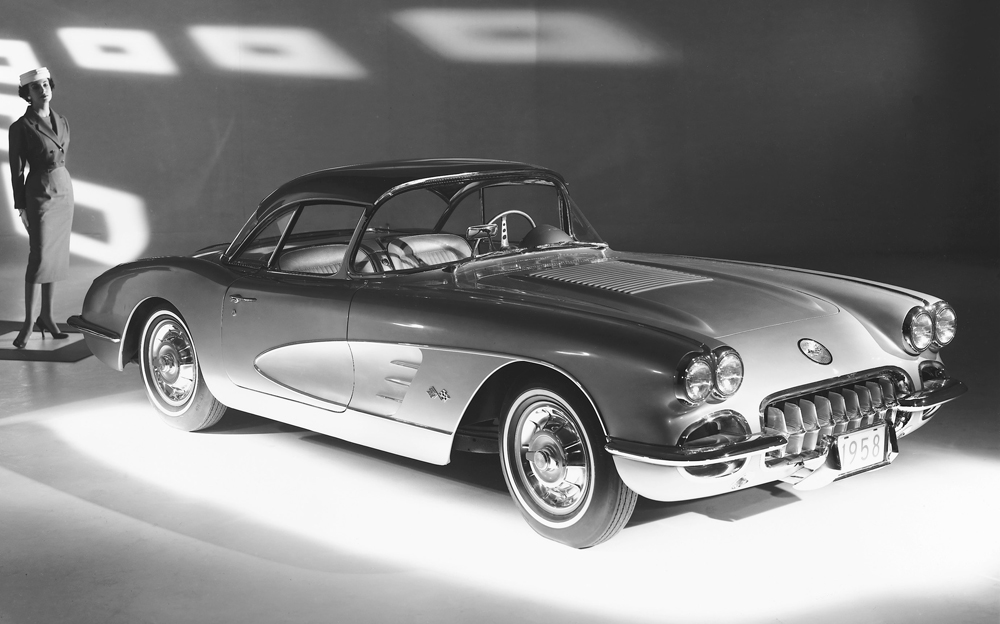
1958
Dual headlamps with separate high- and low-beams appear for the first time on Corvette. Corvette is extensively restyled. Dual headlamps, with separate high- and low-beam lamps, head the list of what’s new. Other changes include a “louvered” hood, two chrome trunk strips, a new dash and new upholstery. Engine power is now as high as 290 hp and the speedometer increases to 160 mph. Fuel is pressure-injected directly at each cylinder intake port, eliminating the carburetor entirely! Optional at extra cost with Powerglide, or 3-speed or 4-speed Synchro-Mesh transmission.
Specifications
- Engine: Valve-in-head V8, 283-cubic-inch displacement, 3.88″ bore x 3.0″ stroke, 9.5:1 compression ratio. 230 h.p. with 4-barrel carburetor. 245 h.p. with twin 4-barrel carburetion. 250 h.p. with Ramjet Fuel Injection. High-lift camshaft. hydraulic valve lifters. Independent operating mechanism for each valve. Precision-machined forged steel crankshaft, five main bearings. Special alloy main and connecting rod bearings. Full-pressure lubrication system with full-flow oil filter. 12-volt electrical system. Engine precision-balanced after assembly. Finned aluminum rocker covers on optional engines. Buffed aluminum oil-wetted air cleaner (paper-element type with fuel injection). Full dual exhaust system. Maximum performance 290 h.p. engine features Ramjet Fuel Injection, 10.5:1 compression ratio, special camshaft, and high-speed valve system with special valves and mechanical valve lifters.
- Transmission: Special 3-speed close-ratio, Synchro-Mesh (2.2:1 low and reverse, 1.31:1 second and 1:1 high) standard. Close-ratio 4-speed Synchro-Mesh optional (2.2:1 first, 1.66:1 second, 1.31:1 third, 1:1 fourth, 2.25:1 reverse). 10″ semi-centrifugal coil spring clutch. Powerglide automatic transmission available with 230, 245, and 250 horsepower engines. Floor-mounted gear or range selector.
- Rear Axle: Semi-floating hypoid. Axle ratios: 3-speed or 4-speed Synchro-Mesh 3.70:1; Powerglide 3.55:1 ratio optional with either 3-speed or 4-speed Synchro-Mesh.
- Chassis: Box-girder, X-member reinforced frame. Independent coil spring front suspension with stabilizer bar. Outrigger-mounted semi-elliptic rear springs. Direct double-acting shock absorbers. Unit-balanced tubular propeller shaft and universal joints. Full anti-friction steering gear and balanced linkage-17:1 overall ratio. Hydraulic 11-inch self-energizing brakes, with fade-resistant linings. Mechanical parking brake on rear wheels. 16.4 gallon fuel tank. Black 6.70 x 15 4-ply rating tubeless tires, white sidewall tires optional. Chrome wheel covers with simulated knock-off hubs.
Exterior: Glass-fiber reinforced plastic body-sculpted side panels. Polished acrylic lacquer finish. Front hinged hood. Three-unit front grille. Dual headlight in front fenders. Cowl ventilator. Large luggage locker with spare wheel under floor. Concealed well for folding top behind seats. Chrome-bound windshield. Functional, wraparound front and rear bumpers mounted to the frame. Dual exhaust ports in rear bumpers. Choice of manually operated fabric folding top or easily removable plastic hardtop.
Interior: Foam rubber padded, all vinyl trimmed bucket seats, individually adjustable. Safety belts. Pushbutton door handles, key lock, inside release. Long padded armrest on each door. Crank-operated windows. Vinyl covered instrument panel crown and doors. Passenger assist bar in instrument panel cove. Carpeted floor, metal door scuff panels, sills and step plates. Competition-type steering wheel. Speedomoter, tachometer, ammeter, fuel level, oil pressure, and coolant temperature gauges, starter-ignition switch, and light switch on instrument panel. Directional signals, cigarette lighter, outside and inside rear view mirrors, dual electric windshields wipers, electric clock. Ashtray and glove compartment between seats.
Optional: Engines, transmissions, axle, and white sidewall tires. Power-operating mechanism and removable plastic hardtop with folding top. Power windows. Transistorized radio, heater, windshield washer. Heavy-duty brakes and suspension package. Special wheels.
Color Options: Silver, Panama Yellow, Black, Regal Turquoise, Snowcrest White, Charcoal, Signet Red and Silver Blue
Dimensions: Wheelbase, 102″. Length, 177.2″. Overall height: folding top, 51.1″ up, 49.2″ down; hardtop, 51″. Height at door, 33″. Road clearance, 5.8″. Width, 72.8″. Tread: 57″ front, 59″ rear.
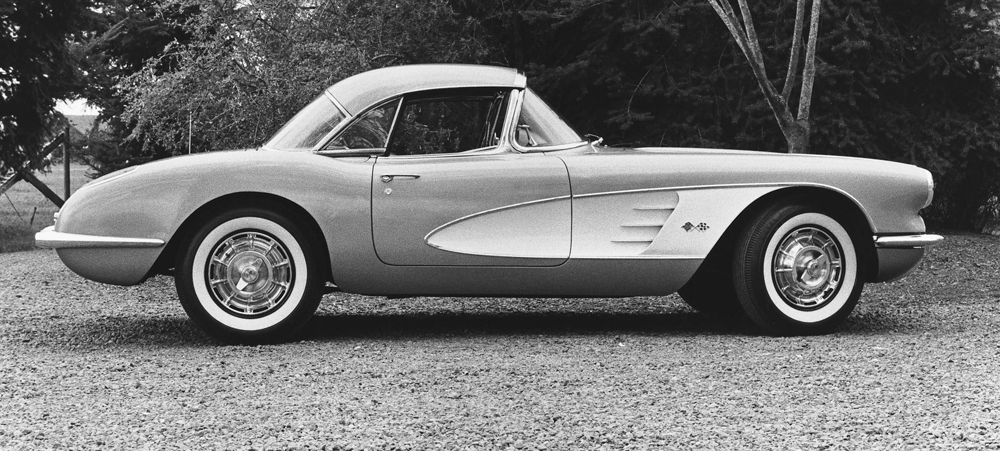
1959
The T-handle shifter debut on Corvette, as does a storage bin under the passenger-side grab handle. The exterior styling is similar to 1958, without the chrome trunk strips and hood ridges. The T-handle shifter makes its debut as do concave gage lenses and a storage bin under the passenger-side grab handle.
Corvette Engines are 283-cubic-inch displacement valve-in-head V8’s with 3.88″ bore and 3.0″ stroke.
230-h.p. Corvette V8 with 4-barrel carburetion, 9.5:1 compression ratio, hydraulic valve lifters, standard equipment.
245- h.p. Corvette V8 with twin 4-barrel carburetion, 9.5:1 compression ratio, hydraulic valve lifters.
250-h.p. Corvette V8 with Ramjet Fuel Injection, 9.5:1 compression ratio, hydraulic valve lifters.
270-h.p. Corvette V8 with twin 4-barrel carburetion, 9.5:1 compression ratio, special camshaft and high-speed valve system with special valves and mechanical valve lifters.
290-h.p. Corvette V8 with Ramjet Fuel Injection, 10.5:1 compression ratio, special camshaft and high-speed valve system with special valves and mechanical valve lifters.
All engines have independent operating mechanism for each valve. Precision-machined forged steel crankshaft, five main bearings. Full pressure lubrication system with full-flow oil filter. 12-volt electrical system. Engines precision balanced after assembly. Finned aluminum rocker covers on optional engines. Buffed aluminum oil-wetted type air cleaner (special paper element tube intake type with Fuel Injection). Full dual exhaust system.
Choice of Transmissions
3-SPEED CLOSE-RATIO SYNCHRO-MESH, standard equipment. Ratios: 2.21:1 low; 1.32:1 second; 1:1 third; 2.51:1 reverse. Floor mounted gearshift.
4-SPEED CLOSE-RATIO SYNCHRO-MESH. Ratios: 2.2:1 first; 1.66:1 second; 1.31:1 third; 1.1 fourth; 2.26:1 reverse with manually operated mechanism on floor mounted shift lever to prevent unintentional reverse engagement during shifting.
POWERGLIDE AUTOMATIC available with 230-,245- and 250-horsepower engines. Floor mounted range selector lever.
CLUTCH. 10″ semi-centrifugal coil spring.
Power-Matched Rear Axles
Semi-floating hypoid.
STANDARD REAR AXLE RATIOS: 3.70:1 with 3-Speed or 4-Speed Synchro-Mesh; 3.55:1 with Powerglide.
POSITRACTION REAR AXLE RATIOS: choice of 3.70:1, 4.11:1, or 4.56:1 ratio with either 3-Speed or 4-Speed Synchro-Mesh.
Box-girder, X-member reinforced frame. Independent coil spring front suspension with stabilizer bar. Rear suspension by radius rods and outrigger-mounted semi-elliptic leaf springs. Direct double-acting shock absorbers. Unit-balanced tubular propeller shaft and universal joints. Full anti-friction steering gear and balanced linkage-17:1 overall ratio. Hydraulic 11-inch self-energizing brakes with fade resistant, bonded linings, heavy-duty sintered-metallic brake linings optional. Mechanical parking brake on rear wheels. 16.4 gallon fuel tank. Black 6.70 x 15 4-ply rating Tyrex cord tubeless tires; white sidewall tires optional. Vented chrome wheel covers with simulated knock-off hubs.
Heavy-duty front and rear springs and larger shock absorbers with stiffer valving heavier front stabilizer and fast steering linkage that gives a 16.3:1 overall ratio. Special brakes with ceramic-metallic facings, finned cast iron brake drums and vented flange plates with air scoops. Used with Positraction rear axle, this equipment is available with 3-Speed or 4-Speed Synchro-Mesh and 270-or 290-h.p. engines. Wide-base wheels with 5 1/2″ rims available. Also nylon cord tires available.
Fiber-glass reinforced plastic body-sculptured side panels. Magic-Mirror acrylic lacquer finish in seven solid colors: Tuxedo Black, Classic Cream, Frost Blue, Crown Sapphire, Roman Red, Snowcrest White, Inca Silver. These colors also available in optional two-tone exteriors with color-keyed Inca Silver or Snowcrest White in the sculptured side panels. Front hinged hood. Three-unit front grille. Dual headlights in front fenders. Push button door handles with key lock. Cowl ventilator. Large luggage locker with spare wheel under floor. Concealed well for folding top behind seats. Folding top available in white, black, turquoise or blue. Chrome-bound windshield. Frame-mounted front and rear bumpers. Dual exhaust ports in rear bumpers. Choice of manually operated rubberized cotton fabric folding soft top or easily removable plastic hardtop (or both at an extra cost). Power-operated mechanism for folding soft top also available.
Interior colors in black, blue, red or turquoise keyed to exterior colors. Foam rubber padded, all vinyl trimmed bucket seats, individually adjustable. Safety belts. Long padded armrest on each door. Recessed safety reflectors in door sidewall panels. Crank-operated windows, power-operated optional. Vinyl-covered instrument panel crown and doors. Passenger assist bar in instrument panel cove. Stowage bin below passenger assist bar. Carpeted floor, metal door scuff panels, sills and step plates. Competition-type steering wheel. Speedometer, tachometer, ammeter, fuel level, oil pressure, and coolant temperature gauges, starter-ignition switch, and light switch on instrument panel. Directional signals, cigarette lighter, outside and inside rear view mirrors, dual electric windshield wipers, electric clock. Ashtray and glove compartment with key lock located between seats. Transistorized radio, heater, parking brake alarm, courtesy light, right and left hand sunshades, and push button windshield washer also available.
Dimensions: Wheelbase, 102″. Overall length 177.2″. Overall height: Soft top up, 51.6; top down, 49.7″; hardtop, 51.5″. Height at door 33.5″.Road clearance, 6.0″. Overall width 72.8″. Tread: front, 57″; rear, 59″.

1960
An aluminum radiator is available on Corvettes for the first time, but limited to high-lift cam engines. Cast aluminum cylinder heads are added to the arsenal under the hood. An optional 315 hp 283 cubic inch V8 is available with the manual transmission exclusively. An aluminum radiator is available for the first time, but its use is limited to the high-lift cam engines. A stabilizer bar is added to the Corvette’s rear suspension.
For Performance- Corvette Engines are 283-cubic-inch displacement valve-in-head V8’s with 3.88″ bore and 3.0″ stroke. 230-H.P. Corvette V8 with 4-barrel carburetion, 9.5:1 compression ratio, hydraulic valve lifters, standard equipment. 245-H.P. Corvette V8 with twin 4-barrel carburetion, 9.5:1 compression ratio, hydraulic valve lifters. 275-H.P. Corvette V8 with Ramjet Fuel Injection 11:1 compression ratio, aluminum cylinder heads, hydraulic valve lifters. 270-H.P. shaft and high-speed valve system with special valves and mechanical valve lifters. All-aluminium cross-flow radiator included. 315-H.P Corvette V8 with Ramjet and high-speed valve system with special valves and mechanical valve lifters. All aluminum cross-flow radiator included.
All engines have independent operating mechanism for each valve. Precision-machined forged steel crankshaft, five main bearings. Full pressure lubrication system with full-flow oil filter. 12-volt electrical system. Engines precision balanced after assembly. Finned aluminum rocker covers on optional engines. Buffed aluminum oil-wetted type air cleaner (special paper element, tube intake type with Fuel Injection). Full dual exhaust system.
Choice of Transmissions- 3-Speed Close-ratio Synchro-mesh standard equipment. Ratios:2.21:1 low; 1.32:1 second; 1:1 third; 2.51:1 reverse; floor mounted gearshift. 4-Speed Close-Ratio Synchro-Mesh. (R.P.O 685) Ratios: 2.2:1 first; 1.66:1 second; 1.31:1 third; 1.1 fourth; 2.26:1 reverse with manually operated mechanism on floor mounted shift lever to prevent unintentional reverse engagement during shifting. Power glide Automatic (R.P.O. 313) available with 230-and 245- horsepower engines. Floor mounted range selector lever. CLUTCH. 10″ semi-centrifugal coil spring.
Power-Matched Rear Axles- Semi-floating hypoid. Standard Rear Axle Ratios:3.70:1 with 3-speed or 4-speed Synchro-Mesh; 3.55:1 with Powerglide. Positraction (R.P.O. 675) Rear Axle Ratios: choice of 3.70:1, 4.11:1 or 4.56:1 ratio with either 3-speed or 4-speed synchro-mesh.
Chassis- Box-girder, X-member reinforced frame. Independent coil spring front suspension with stabilizer bar. Rear suspension by radius rods and outrigger-mounted semi-elliptic leaf springs with stabilizer bar. Direct double action nitrogen bag shock absorbers. Unit-balanced tubular propeller shaft and universal joints. Full anti-friction steering gear and balanced linkage-21:1 overall ratio. Hydraulic 11-inch self-energizing brakes with fade-resistant, bonded linings. Mechanical parking brake on rear wheels. 16.4- gallon fuel tank. Black 6.70 x 15 4-ply rating Tyrex cord tubeless tires, white sidewall tires optional. Vented chrome wheel covers with simulated knock-off hubs.
Special Equipment For Sports Car Meets- R.P.O. 687-Special brakes with sintered-metallic facings, finned cast iron brake drums with built-in cooling fan, vented flange plates with air scoops, and fast steering adapter for 16.3:1 overall ratio. Used with Positraction rear axle, this equipment is available with 3-Speed or 4-Speed Synchro-Mesh and 270- or 315- H.P. engine. R.P.O. 686-Special sintered metallic brake linings available with 3-Speed or 4-Speed Synchro Mesh. F.O.A. 121- Temperature- controlled viscous drive fan. R.P.O. 276- Wide-base wheels with 5 1/2″ rims. L.P.O. 1408-Nylon cord tubeless tires, 6.70 x 15 4-ply rating.
Body Exterior- Fiber-glass reinforced plastic body-sculptured side panels. Magic-mirror acrylic lacquer finish in eight solid colors: Tuxedo Black, Ermine White, Roman Red, Sateen Silver, Horizon Blue, Tasco Turquoise, Cascade Green, Honduras Maroon. These colors are also available two-tone exteriors with color-keyed Sateen Silver or Ermine White in the sculpted side panels. Front hinged hood. Three unit front grille. Dual headlights in front fenders. Push button door handles and key lock. Cowl ventilator. Large luggage locker with spare wheel under floor. Concealed well for folding top behind seats. Choice of manually operated rubberized fabric folding soft top or easily removable plastic hardtop. Power-operating mechanism for folding soft top. Frame-mounted front and rear bumpers.
Interior Features- Interior colors in black, blue, red or turquoise keyed to exterior colors. Foam rubber padded all-vinyl trimmed bucket seats, individually adjustable. Safety belts. Long padded armrest on each door. Recessed safety reflectors in door sidewall panels. Crank-operated windows, power-operated optional. Vinyl-covered instrument panel. Passenger assist bar in instrumental panel cove with stowage bin below. Bright aluminum and vinyl sidewall trim. Carpeted floor, metal sills and step plates. Competition-type steering wheel. Speedometer, tachometer, ammeter. Fuel level oil pressure and coolant temperature gauges, starter-ignition switch, and light switch on instrument panel. Directional signals, cigarette lighter, outside and inside rear view mirrors, dual electric windshield wipers, electric clock. Ashtray and glove compartment with key lock located between seats. Transistorized radio, heater, parking brake alarm, courtesy light, right-and-left-hand sunshades and push button windshield washer also available.
Dimensions- Wheelbase. 102″. Overall length, 177.2″. Overall height: Soft top up, 51.6″; top down, 49.7″; hardtop, 51.5″. Height at door, 33.5″. Road clearance. 5.9″. Overall width, 72.8″. Tread: front, 57″; rear, 59″.
Total Production for 1960 was 10,261 Corvettes Built, All Convertibles

1961
This marks the first time a four round taillamp design is used on Corvette. The aluminum radiator becomes standard. Visual changes for the model year include new side emblems and the first use of four round taillamps, a trend evident in the 1997 Corvette. Exhaust tips exit below the body and the headlamp bezels are body color. A mesh appearance in the front grille replaces the heavy “teeth.”
For Performance: Corvette Engines are 283-cubic-inch displacement valve-in-head V8’s with 3.88” bore and 3.0” stroke, precision balanced assembly. All engines have independent operating mechanism for each valve, precision-machined forged steel crankshaft, five main bearings, full-pressure lubrication system, full-flow oil filter, 12-volt electrical system, full dual exhaust. Oil-wetted, polyurethane element, buffed aluminum air cleaner (special paper element, tube intake type with Fuel injection). All-aluminum cross-flow radiator. Finned aluminum rocker covers on optional engines. 270*- and 315*- h.p. Corvette V8’s feature special camshaft; high-speed valve system with special valves and mechanical valve lifters; heavy-duty main and connecting rod bearing; distributor-driven tachometer; straight-through type mufflers. Fuel Injection engines have special cylinder heads, pistons, and larger intake valves.
Choice of Transmissions: 3-Speed Synchro-mesh standard equipment. Ratios: 2.47:1 low; 1.53:1 second; 1:1 third; 2.80:1 reverse; floor-mounted gearshift. 4-Speed close-ratio Synchro-Mesh* (R.P.O. 685) Ratios 2.2:1 first; 1.66:1 second; 1.31:1 third; 1.1 fourth; 2.26:1 reverse with manually operated mechanism on floor mounted shift lever to prevent unintentional reverse engagement during shifting. Clutch, 10” semi-centrifugal coil spring. Powerglide automatic (R.P.O. 313) available with 230- and 245- horsepower engines. Floor mounted range selector level.
Power-Matched Rear Axles: Semi-floating hypoid. Rear axle ratios matched to power team. Positraction (R.P.O. 675) rear axle optional* with 3- or 4- speed Synchro-Mesh and choice of ratios. With 3-Speed Synchro-Mesh 3.36:1, 4.11:1, 4.56:1. With 4-Speed Synchro-Mesh 3.70:1, 4.11:1, 4.56:1.
Chassis: Box-girder, X-member reinforced frame. Independent coil spring front suspension with stabilizer bar. Rear suspension by radius rods and outrigger-mounted semi-elliptic leaf springs with stabilizer bar. Direct double-action nitrogen bag shocks absorbers. Unit-balanced tubular propeller shaft and universal joints. Full anti-friction steering gear and balanced linkage- 21:1 overall ratio. Hydraulic 11-inch self-energizing brakes with fade-resistant bonded linings. Hand-operated parking brake on rear wheels. 16.4-gallon fuel tank. Black 6.70 x 15 4-ply rating Tyrex cord tubeless tires, white sidewall tires optional*. Vented chrome wheel covers with simulated knock-off hubs.
Special Equipment For Sports Car Meets: R.P.O. 687 – Special brakes with sintered-metallic facings, finned cast iron brake drums with built-in cooling fan, vented flange plates with air scoops, and fast steering adapter for 16.3:1 overall ratio. Available with Positraction rear axle, 3-Speed or 4-Speed Synchro-Mesh, and 270- or 315-h.p. engine R.P.O. 686 – Special sintered-metallic brake linings available with 3-Speed or 4-Speed Synchro-Mesh. F.O.A. 121 – Temperature-controlled viscous drive fan. R.P.O. 276 – Wide-base wheels with 5 ½” rims; hub caps replace wheel covers. L.P.O. 1408 – Nylon cord tubeless tires, 6.70 x 15 4-ply rating. L.P.O. 1625A – 24-gallon fuel tank.
Body Exterior: Fiber glass reinforced plastic body – sculpted side and rear panels. Magic-Mirror acrylic lacquer finish in seven solid colors: Tuxedo Black, Ermine White, Roman Red, Sateen Silver, Jewel Blue, Fawn Beige, Honduras Maroon. These colors also available in optional* two-tone exteriors with color-keyed Sateen Silver or Ermine While in the sculptured side panels. Front hinged hood. Three-unit front grille. Dual headlights in front fenders. Four taillights. Push-button door handles and key lock. Cowl ventilator. Large luggage locker with spare wheel under floor. Concealed well for folding top behind seats. Choice of manually operated rubberized fabric folding soft top or easily removable plastic hardtop. Power-operating mechanism* for folding soft top. Frame-mounted front and rear wraparound bumpers.
Interior Features: Interior colors in black, blue, red or fawn keyed to exterior colors. Foam rubber padded all-vinyl trimmed bucket seats, individually adjustable. Safety belts. Long padded armrest on each door. Recessed safety reflectors in door sidewall panels. Crank-operated windows, power-operated optional*. Vinyl-covered padded instrument panel. Passenger assist bar in instrumental panel cove with stowage bin below. Bright aluminum and vinyl sidewall trim. Carpeted floor, metal sills and step plates. Competition-type steering wheel. Speedometer, tachometer, ammeter, fuel level, oil pressure and coolant temperature gauges, starter ignition switch with accessory position, and light switch on instrument panel. Directional signals, cigarette lighter, outside and inside rearview mirrors, two speed electric link-driven windshield washer. Ashtray and glove compartment with key lock located between seats. Transistorized push-button signal-seeking radio*, and heater* also available.
Dimensions: Wheelbase, 102”. Overall length 177.2”. Overall height: Soft top up, 52.2”; top down 50.2”; hardtop, 51.5”. Height at door, 33.5”. Road clearance, 6.7”. Overall width, 70.4”. Tread: front 57”; rear 59”.
Total Production for 1961 was 10,939 Corvettes Built, All Convertibles
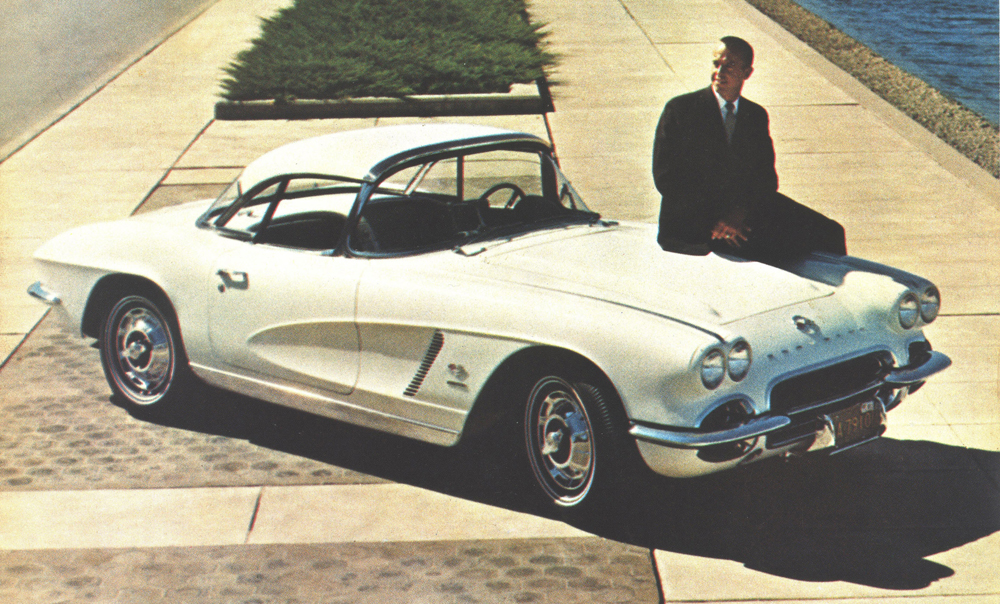
1962
Corvette’s last year with exposed headlamps, a solid rear axle and a trunk opening. A 327 cubic inch V8 with horsepower ranging from 250 to 360, depending on the equipment, is introduced. The Powerglide automatic transmission has a new aluminum case. This is Corvette’s last year with exposed headlamps, a solid rear axle and a trunk opening. The 1962 issue of Corvette News featured Alan B. Shepard with a white, 1962 Corvette coupe featuring a customized, space-age interior.
For Performance: Corvette engines are 327-cubic-inch displacement valve-in-head V8s with 4.0” bore and 3.25” stroke, precision balanced as an assembly. All engines have independent operating mechanism for each valve, precision-machined forged steel crankshaft, five premium aluminum main bearings, full pressure lubrication system, full-flow oil filter, automatic choke, 12-volt electrical system, 30-amp. generator (35-amp. optional*), full dual exhaust. Oil-wetted, polyurethane element, buffed aluminum air cleaner (special tube intake type with Fuel Injection). Distributor-driven tachometer. All-aluminum cross-flow radiator. Finned aluminum rocker covers and 35-amp. generator on high-output optional engines. 250-hp standard Corvette V8 – Features 4-barrel carburetor, modified intake manifold, large intake valves, large exhaust manifolds, 10.5:1 compression ratio. In addition, 340-hp (with large aluminum-bodied 4-barrel carburetor) and 360-hp (With Ramjet Fuel Injection) Corvette V8s feature special cast iron cylinder heads with large ports; domed aluminum pistons for 11.25:1 compression ratio and special camshaft; high-speed valve system with specifically finished lightweight valves. Mechanical valve lifters. Dual point distributor, full centrifugal advance.
Choice of Transmissions: 3-Speed Synchro-Mesh, standard equipment. Ratios: 2.47:1 low; 1.53:1 second; 1:1 third; 2.80:1 reverse; floor-mounted gearshift. 4-Speed close ratio Synchro-Mesh*. RPO 685A (with standard 250- or optional 300-hp V8)-Ratios: 2.54:1 first; 1.92:1 second; 1.51:1 third; 1:1 fourth; 2.61:1 reverse. RPO 685B (with optional 340- or 360-hp V8)-Ratios: 2.20:1 first; 1.66:1 second; 1.31:1 third; 1:1 fourth; 2.26:1 reverse. Both 4-Speed transmissions have manually operated mechanism on floor mounted shift lever to prevent unintentional reverse engagement during shifting. Clutch: 10” semi-centrifugal coil spring. Powerglide* Automatic (RPO 313 available with 250- and 300-hp Corvette V8). Floor mounted range selector lever.
Power-Matched Rear Axles: Semi-floating hypoid. Ratios matched to power team. Positraction (RPO 675) rear axles optional* with all transmissions.
Chassis: Box-Girder X-member reinforced frame. Independent coil spring front suspension with heavy stabilizer bar. Rear suspension by radius rods and outrigger-mounted semi-elliptic leaf springs with stabilizer bar. Direct double action nitrogen bag shock absorbers. Unit-balanced tubular propeller shaft and universal joints. Full anti-friction steering gear and balanced linkage – 21:1 overall ratio. Hydraulic 11-inch self-energizing brakes with fade resistant bonded linings. Hand operated parking brake on rear wheels. 16.4-gallon fuel tank. Black 6.70 x 15 tubeless tries. White sidewall or nylon cord tires optional*. Vented chrome wheel covers with simulated knockoff hubs.
Special Equipment For Sports Car Meets: RPO 687 – Heavy-Duty Chassis Equipment includes special brakes with sintered-metallic facings, finned cast iron brake drums with built-in cooling fan, vented flange plated with air scoops, fast steering adapter for 16.3:1 overall ratio, heavy-duty front and rear shock absorbers**. RPO 276 – Wide-base wheels with 5 ½” rims (with hub caps instead of wheel covers). RPO 686 – Special sintered-metallic brake linings. RPO 488 – 24-gallon fuel tank. RPO 441 – off-the-road exhaust system.
Body Exterior: Fiber-glass reinforced plastic body – sculptured side and rear panels. Cove trim and rocker panel moldings. Magic-Mirror acrylic lacquer finish in seven solid colors: Tuxedo Black, Ermine White, Roman Red, Sateen Silver, Almond Beige, Honduras Maroon, and Fawn Beige. Front hinged hood. Three-unit front griller. Dual headlights in front fenders. Four taillights. Push-button door handles and key lock. Cowl ventilator. Large luggage locker with spare wheel under the floor. Concealed well for folding top behind seats. Choice of manually operated folding soft top or easily removable plastic hard top (Second top optional*). Power-operated mechanism* for folding soft top. Frame-mounted wraparound bumpers.
Interior Features: Interior colors in black, red or fawn keyed to exterior colors. Foam-rubber padded all-vinyl bucket seats, individually adjustable. Safety belts. Long padded armrest on each door. Recessed safety reflectors in door sidewall panels. Crank-operated windows, power-operated optional*. Vinyl-covered padded instrument panel. Passenger assist bar in instrument panel cover with stowage bin below. Pleated leather-grain vinyl sidewall trim. Carpeted floor, metal sills and step plates. Competition-type steering wheel. Speedometer, tachometer, ammeter, fuel level, oil pressure and coolant temperature gauges, starter-ignition switch and light switch on instrument panel. Built-in, outside air heater-defroster with controls on center console. Directional signals, cigarette lighter, outside and inside rearview mirrors, dual electric link-driven windshield wipers, electric clock, parking brake alarm, courtesy light, right- and left-hand sunshades and push-button windshield washer. Ashtray, glove compartment with key lock located between seats. Transistorized signal-seeking radio* also available.
Dimensions: Wheelbase, 102”. Overall length, 177.2”. Overall height: Soft top up, 52.2”; top down, 50.1”; hardtop 52.1”. Height at door, 32.2”. Road clearance, 6.7”. Overall width, 70.4”. Tread: front, 57”; rear 59”.
Total Production for 1962 was 14,531 Corvettes Built, All Convertibles
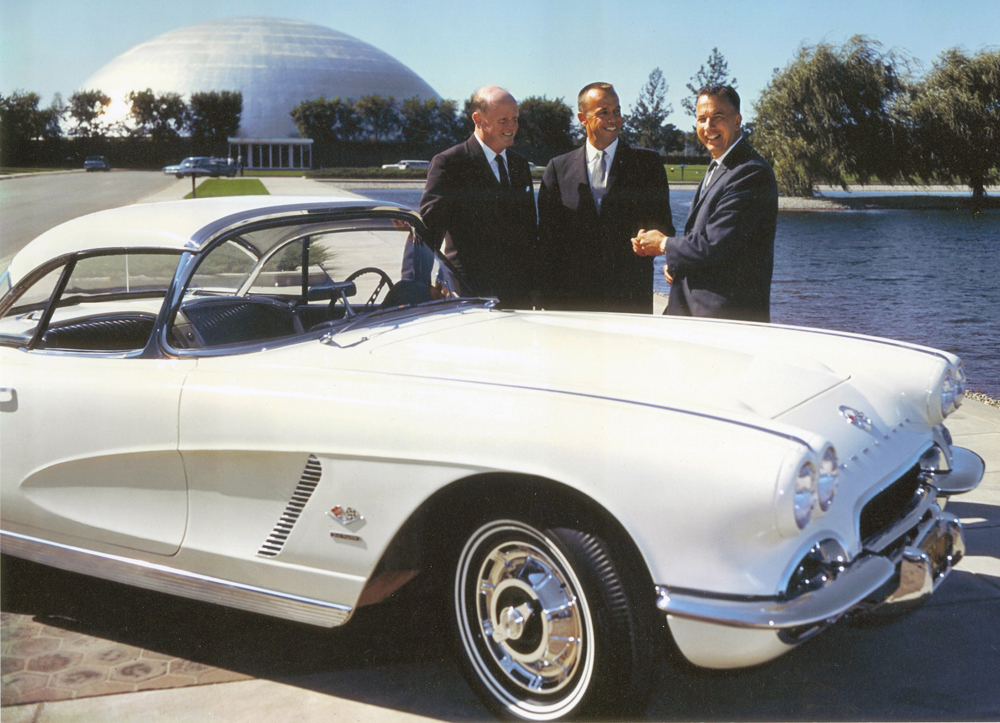
Corvettes and Astronauts
On May 5, 1961, Alan B. Shepard became the first American to travel into outer space. When he returned to terra firma, Shepard got behind the wheel of a Chevrolet Corvette – and the legends of America’s favorite sports car and spacemen have been intertwined ever since.
On May 7, 2011, approximately 30 of America’s surviving astronauts are expected to gather at Cocoa Beach, Fla., where they will participate in a parade commemorating the 50th anniversary of Shepard’s historic sub-orbital flight. Fittingly, they will be driven in Corvettes representing all six design generations built since the famed sports car’s 1953 debut.
“Each astronaut will ride in a Corvette from the generation current at the time of their mission,” parade coordinator John T. R. Dillon III said.
Dillon, a Safety Engineer at the Kennedy Space Center, is also a Corvette owner and member of the Cape Kennedy Corvette Club, which counted four astronauts among its original membership when it was founded in 1967.
“All of the astronauts were test pilots back then; they flew performance aircraft and they moved into performance cars with a well-honed appreciation for handling, acceleration and so forth,” Dillon said.
Shepard brought along his 1957 Corvette when he reported for Space Program training in April, 1959…he would own at least 10 Corvettes in his lifetime. His enthusiasm for sports cars was shared by several of the other adventurous and dedicated young men who would train with him to become America’s first astronauts.
Shortly after Shepard’s historic flight, then General Motors Executive Edward N. Cole presented the astronaut with a new, white, 1962 Corvette. The car had been outfitted by GM designers with a customized space-age interior. As GM did not routinely give away cars, the Corvette-astronaut connection might have become totally coincidental in the years that followed, had not Florida Chevrolet dealer Jim Rathmann stepped into the picture.
After winning the 1960 Indianapolis 500 as a professional racer, Rathmann opened a Chevrolet-Cadillac dealership at Melbourne, Fla., near the Space Center, in 1961. Sensing that most of the spacemen were at heart Corvette types, Rathmann negotiated a special lease arrangement with Chevrolet to put them into the sports cars.
Six of the Mercury astronauts would take Rathmann up on his Corvette offer. Stalwart family man John Glenn opted for a new Chevrolet station wagon instead. Glenn’s wagon reportedly proved just the thing for those occasions when the seven astronauts needed to travel together.
During an interview in 1998, Rathmann said, “Al Shepard was a racer…he was always wanting to be the fastest guy.”
That ambition was shared by fellow Mercury astronaut Virgil “Gus” Grissom. The two-lane blacktop duels fought by Shepard and Grissom in their big block-powered Corvettes would truly become the stuff of legend. In his quest for a competitive edge, Grissom had his last Corvette, a 1967 convertible, specially geared and modified to accept extra-wide rear racing tires.
When Apollo 12 astronauts Dick Gordon, Charles Conrad and Alan Bean ordered new 1969 Corvettes through Rathmann, they asked that the identically equipped 390-hp 427 Stingray coupes be custom finished in a special black-accented Riverside Gold color scheme designed by Bean. A unique red, white and blue insignia was also added to the front fenders. NASA administrators reportedly fretted that a subsequently published LIFE Magazine photo of the space-suited Apollo 12 astronauts and their matching Corvettes could be misconstrued as a forbidden product endorsement.
Even so, another photo of a trio of American astronauts with their Corvettes would appear in LIFE, during June 1971. Apollo 15 lunar mission crewmembers Jim Irwin, Al Worden and Dave Scott had been photographed with their Corvettes and a training version of the battery-powered Lunar Rover Vehicle (LRV) they would deliver to the moon. The “moon buggy,” as it was also called, utilized a mobility system built by General Motors. The Apollo 15 crew Corvettes were each a different color…red, white and blue. Dual racing stripes on each car rounded out the American flag colors.
The enduring association with America’s astronauts has contributed greatly to the legend of the Corvette.
“In the 1960s, astronauts were the American heroes that every child idolized and every adult respected,” said Corvette historian and former Corvette Quarterly editor Jerry Burton. “That so many of them drove Corvettes really helped to establish Corvette as America’s sports car.”
Released in 1979, author Tom Wolfe’s bestselling book, “The Right Stuff,” recounted the beginnings of America’s space program. The book’s success sparked a revival of interest in the original Mercury 7 space heroes—and their Corvette adventures.
“Prior to that, astronaut-related Corvette stories were just kind of folklore…I think that it is thanks to Tom Wolfe that the Corvette is today so solidly cemented to the legend of the pioneering astronauts,” said Burton.
That association continues even today. The 1995 movie “Apollo 13” featured two era-authentic Corvettes, one of them used in a key scene featuring Tom Hanks as astronaut Jim Lovell. The 2009 movie “Star Trek XI” opens in the year 2245, with a 12-year old James T. Kirk driving a 280-year old 1965 Corvette Sting Ray.
These stories, both fiction and non-fiction, contribute to the persistent urban legend that astronauts have owned more Corvettes than any other kind of car. That is likely a timeworn legacy of the first decade of the American Space Program. It is probably fair to say, however, that more astronauts have had more fun behind the wheel of America’s Sports Car than in any other automobile.

You must be logged in to post a comment.